Experimental Work to Investigate the Effect of Rooftop PV Panel Shading on Building Thermal Performance
Abstract
1. Introduction
2. Materials and Methods
2.1. Rooftop Experiment Settings
2.2. Roof Thermal Resistance
2.3. Heating and Cooling Load
- —Heat flux (W/m2)
- —Overall heat transfer coefficient (W/m2 °C)
- —Temperature difference between the roof tile and the inner air space (T1–T7)
- ∆t—Time step 1/6 h (10 min step)
- —Daily heat loss or heat gain from the roof in (Wh/m2).
3. Long-Term Measurements and Results
The Effect of Different Weather Conditions on Roof Temperatures
4. Case Study
- Qh,pv—Heating load for rooftop PV house MJ/m2 of conditioned floor area.
- Qc,pv—Cooling load for rooftop PV house MJ/m2 of conditioned floor area.
- Qh—Heating load for house without PV panels, MJ/m2 of conditioned floor area.
- Qc—Cooling load for house without PV panels, MJ/m2 of conditioned floor area.
- Acond—Conditioned floor area (m2).
- Aroof—Roof area covered by PV panels (m2).
- —Energy increased in space heating MJ/m2 of the rooftop PV area.
- —Energy saved in space cooling MJ/m2 of the rooftop PV area.
5. Conclusions
Author Contributions
Funding
Data Availability Statement
Conflicts of Interest
Nomenclatures
| Acond | Conditioned floor area (m2) |
| Aroof | Roof area covered by PV panels (m2) |
| Heat flux (W/m2) | |
| Energy increased in space heating MJ/m2 of the rooftop PV area | |
| Energy saved in space cooling MJ/m2 of the rooftop PV area | |
| Daily heat loss or heat gain from the roof in (Wh/m2) | |
| Qc | Cooling load for house without PV panels, MJ/m2 of conditioned floor area |
| Qc,pv | Cooling load for rooftop PV house MJ/m2 of conditioned floor area |
| Qh | Heating load for house without PV panels, MJ/m2 of conditioned floor area |
| Qh,pv | Heating load for rooftop PV house MJ/m2 of conditioned floor area |
| R | Thermal resistance (m2 °C/W) |
| Overall heat transfer coefficient (W/m2.°C) | |
| ∆t | Time step |
| Temperature difference between the roof tile and the inner air space |
References
- Yang, H.; Zhu, Z.; Burnett, J.; Lu, L. A Simulation Study on the Energy Performance of Photovoltaic Roofs. ASHRAE Trans. 2001, 107, 129–135. [Google Scholar]
- Kotak, Y.; Gago, E.J.; Mohanty, P.; Muneer, T. Installation of Roof-Top Solar PV Modules and their Impact on Building Cooling Load. Build. Serv. Eng. Res. Technol. 2014, 35, 613–633. [Google Scholar] [CrossRef]
- Dominguez, A.; Kleissl, J.; Luvall, J.C. Effects of solar photovoltaic panels on roof heat transfer. Sol. Energy 2011, 85, 2244–2255. [Google Scholar] [CrossRef]
- Kapsalis, V.; Karamanis, D. On the effect of roof added photovoltaics on building’s energy demand. Energy Build. 2015, 108, 195–204. [Google Scholar] [CrossRef]
- Buonomano, A.; Calise, F.; Ferruzzi, G.; Palombo, A. Innovative technologies for NZEBs: An energy and economic analysis tool and a case study of a non-residential building for the Mediterranean climate. Energy Build. 2016, 121, 318–343. [Google Scholar] [CrossRef]
- Wang, Y.; Wang, D.; Liu, Y. Study on comprehensive energy-saving of shading and photovoltaics of roof added PV module. Energy Procedia 2017, 132, 598–603. [Google Scholar] [CrossRef]
- Odeh, S. Thermal Performance of Dwellings with Rooftop PV Panels and PV/Thermal Collectors. Energies 2018, 11, 1879. [Google Scholar] [CrossRef]
- Shukla, N.; Kapsis, K.; Castleberry, K.; Townsend, T.; Mamishev, A. Thermal impact of adhesive-mounted rooftop PV on underlying roof shingles. Sol. Energy 2018, 174, 957–966. [Google Scholar] [CrossRef]
- Barone, G.; Buonomano, A.; Forzano, C.; Palombo, A. Passive and active performance assessment of building integrated hybrid solar photovoltaic/thermal collector prototypes: Energy, comfort, and economic analyses. Energy 2020, 209, 118435. [Google Scholar] [CrossRef]
- Brown, K.E.; Baniassadi, A.; Pham, J.V.; Sailor, D.J.; Phelan, P.E. Effects of Rooftop Photovoltaics on Building Cooling Demand and Sensible Heat Flux Into the Environment for an Installation on a White Roof. J. Eng. Sustain. Build. Cities 2020, 1, 021001. [Google Scholar] [CrossRef]
- Pandiaraj, S.; Thirumaran, R.; Pandian, A.T.; Ravichandran, R.; Easwaran, R.; Chandran, S.; Subramaniam, U. A study of solar heat gain variation in building applied photovoltaic buildings and its impact on environment and indoor air quality. Energy Sources Part A Recovery Util. Environ. Eff. 2022, 44, 6192–6212. [Google Scholar] [CrossRef]
- Bhuvad, S.S.; Udayraj, N. Investigation of annual performance of a building shaded by rooftop PV panels in different climate zones of India. Renew. Energy 2022, 189, 1337–1357. [Google Scholar] [CrossRef]
- Ma, Z.; Gao, X.; Sun, J.; Wang, Y.; Li, W. Shading effect and energy-saving potential of rooftop photovoltaic on the top-floor room. Sol. Energy 2023, 265, 112099. [Google Scholar] [CrossRef]
- Vakilinezhad, R.; Ziaee, N. Assessing the combined effect of PV panels’ shading and cool materials on building energy loads in different climates. Environ. Dev. Sustain. 2023, 6, 16201–16221. [Google Scholar] [CrossRef]
- Zhan, Q.; Ma, Y.; Lin, Z.; Yin, S.; Xiao, Y. Comparative experimental study on the thermal and energy performance of photovoltaic and green roofs in hot-humid climates. Build. Environ. 2025, 271, 112587. [Google Scholar] [CrossRef]
- Insulation Council of Australia and New Zealand. Insulation Handbook, Part 1: Thermal Performance, Version 3; ICANZ: Melbourne, Australia, 2016; pp. 10–33. [Google Scholar]
- Holman, J.P. Heat Transfer, 10th ed.; McGraw-Hill: New York, NY, USA, 2010. [Google Scholar]
- Bureau of Meteorology. Climate Data Online. Available online: http://www.bom.gov.au/climate/data/ (accessed on 25 May 2025).
- Commonwealth Scientific and Industrial Research Organisation (CSIRO). AccuRate Sustainability, Version 2.4.3.21 SP1; CSIRO Publishing: Clayton, Australia, 2019.
- National Construction Code. Housing Energy Efficiency Handbook; Version 1.1; Australian Building Codes Board: Canberra, Australia, 2024; p. 10. [Google Scholar]
- SMA Solar Technology AG. Sunny Design Software, Version 5.92.1; SMA Solar Technology AG: Niestetal, Germany, 2025.
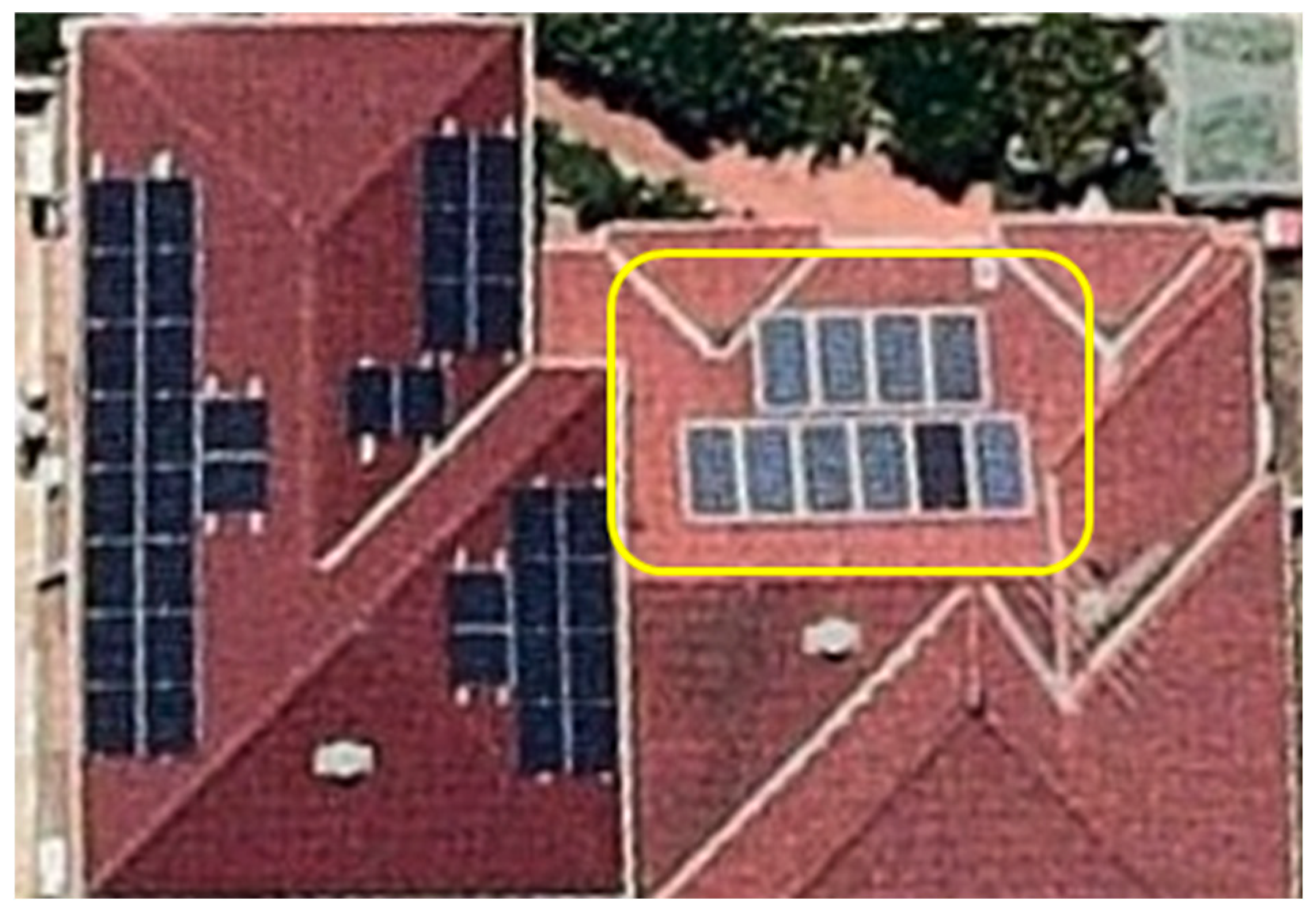
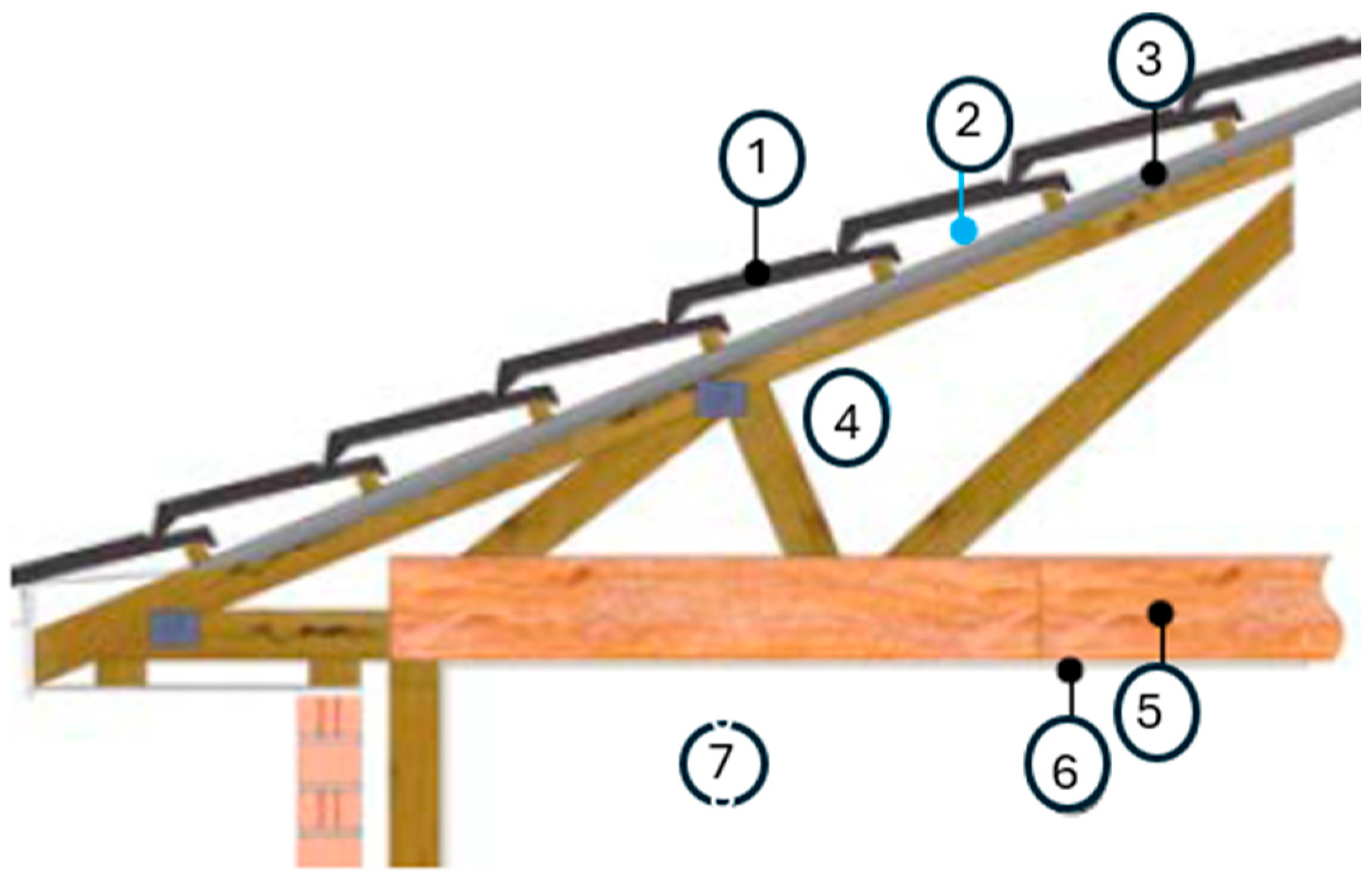

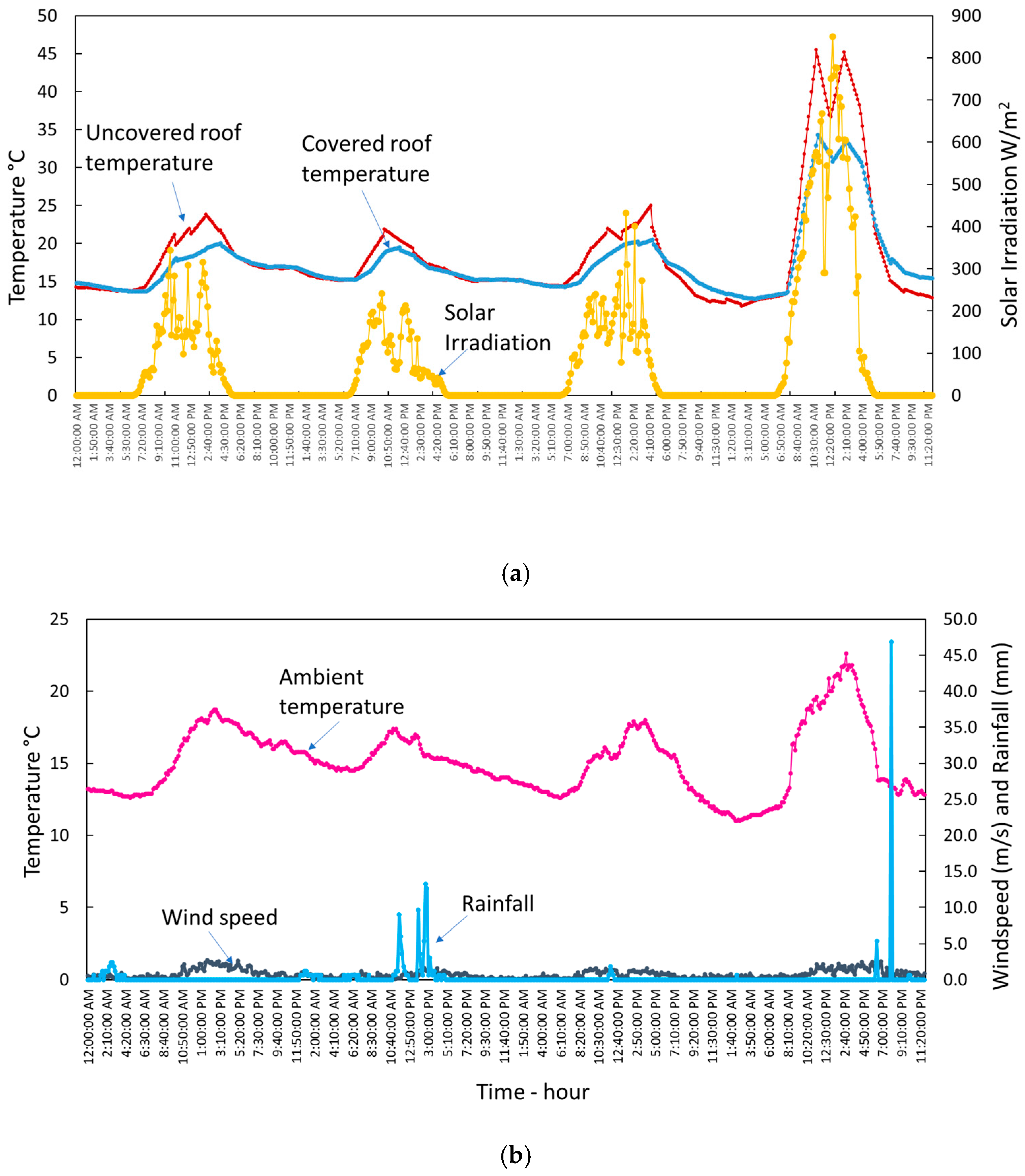
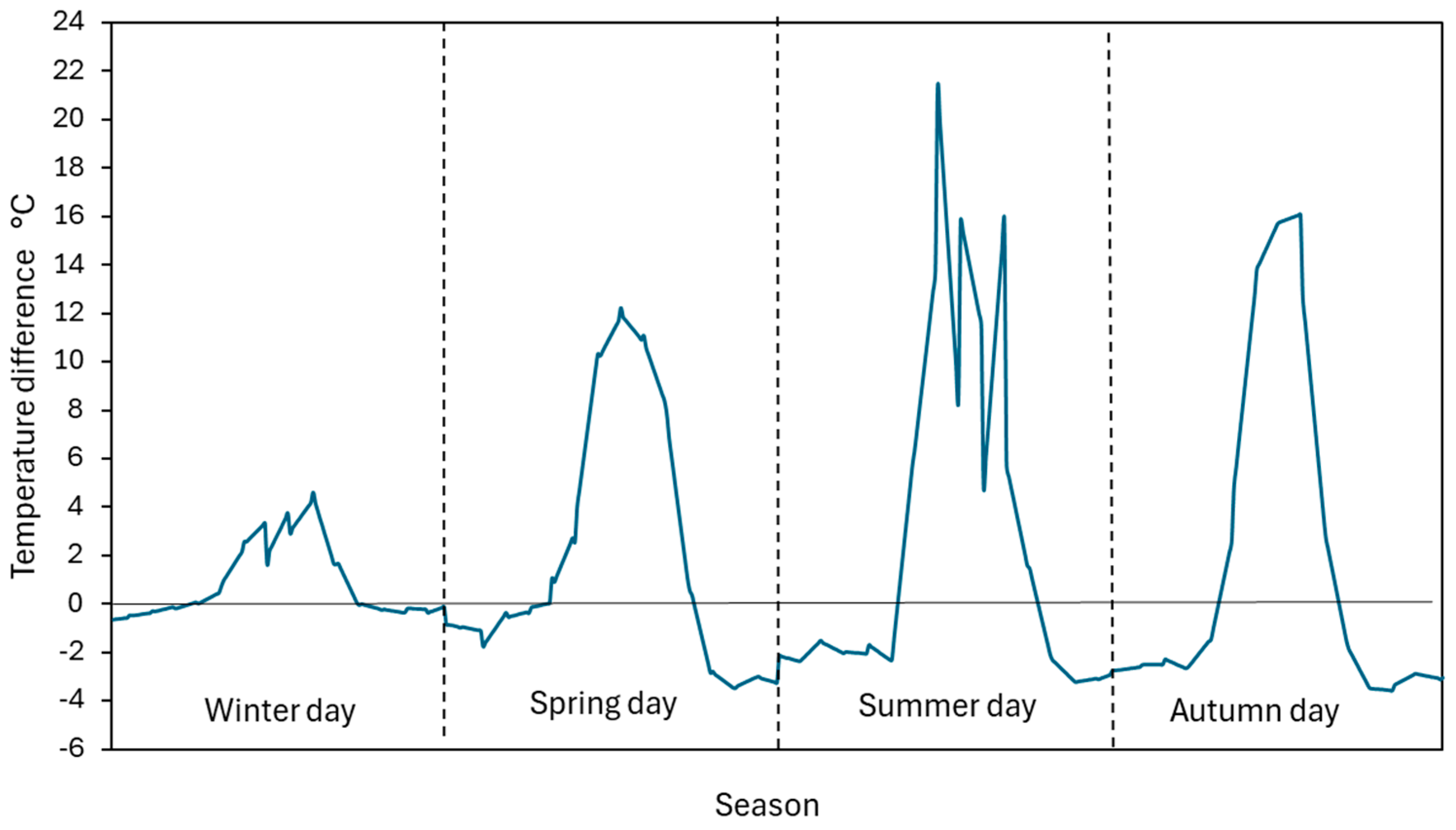
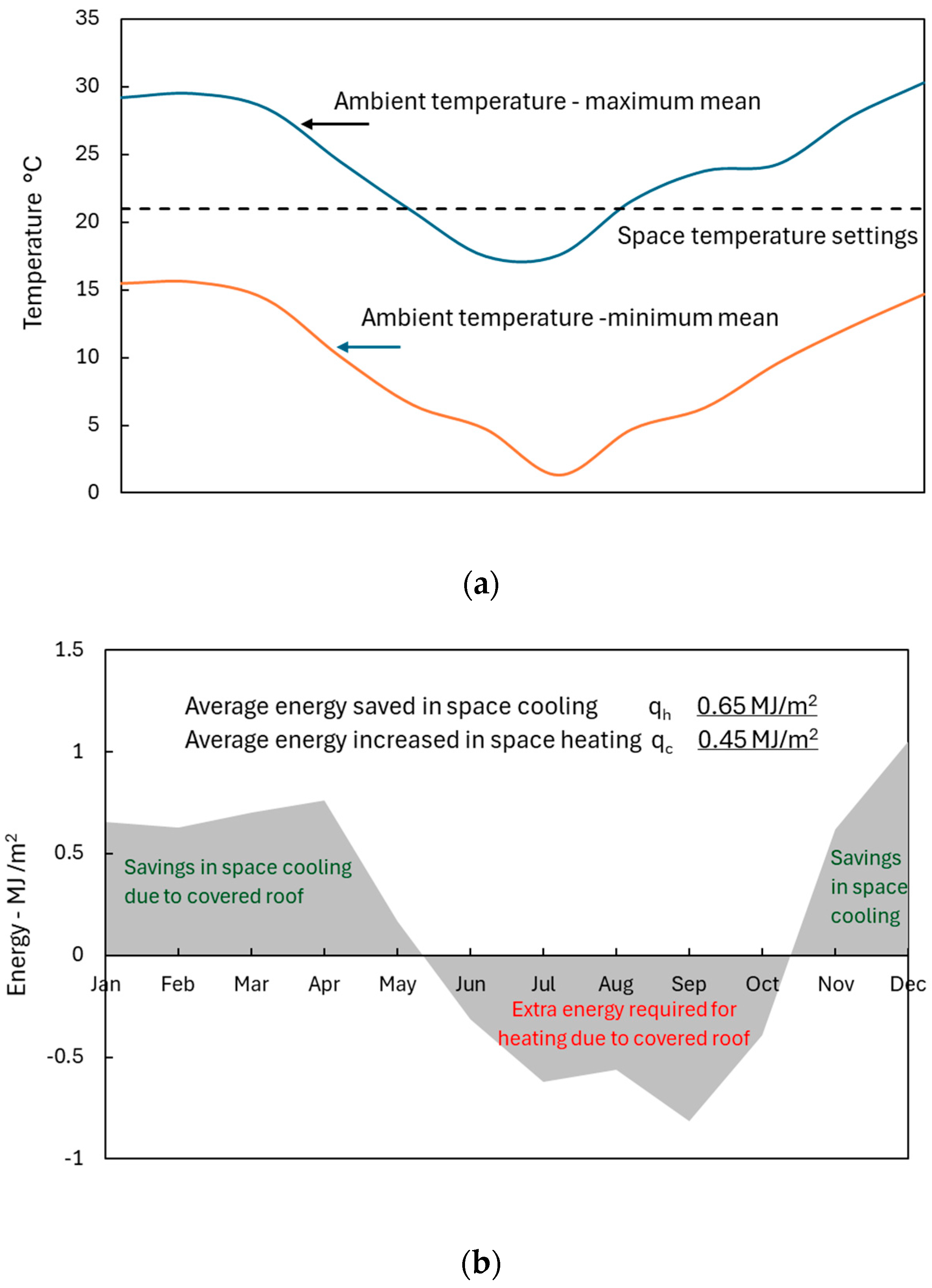
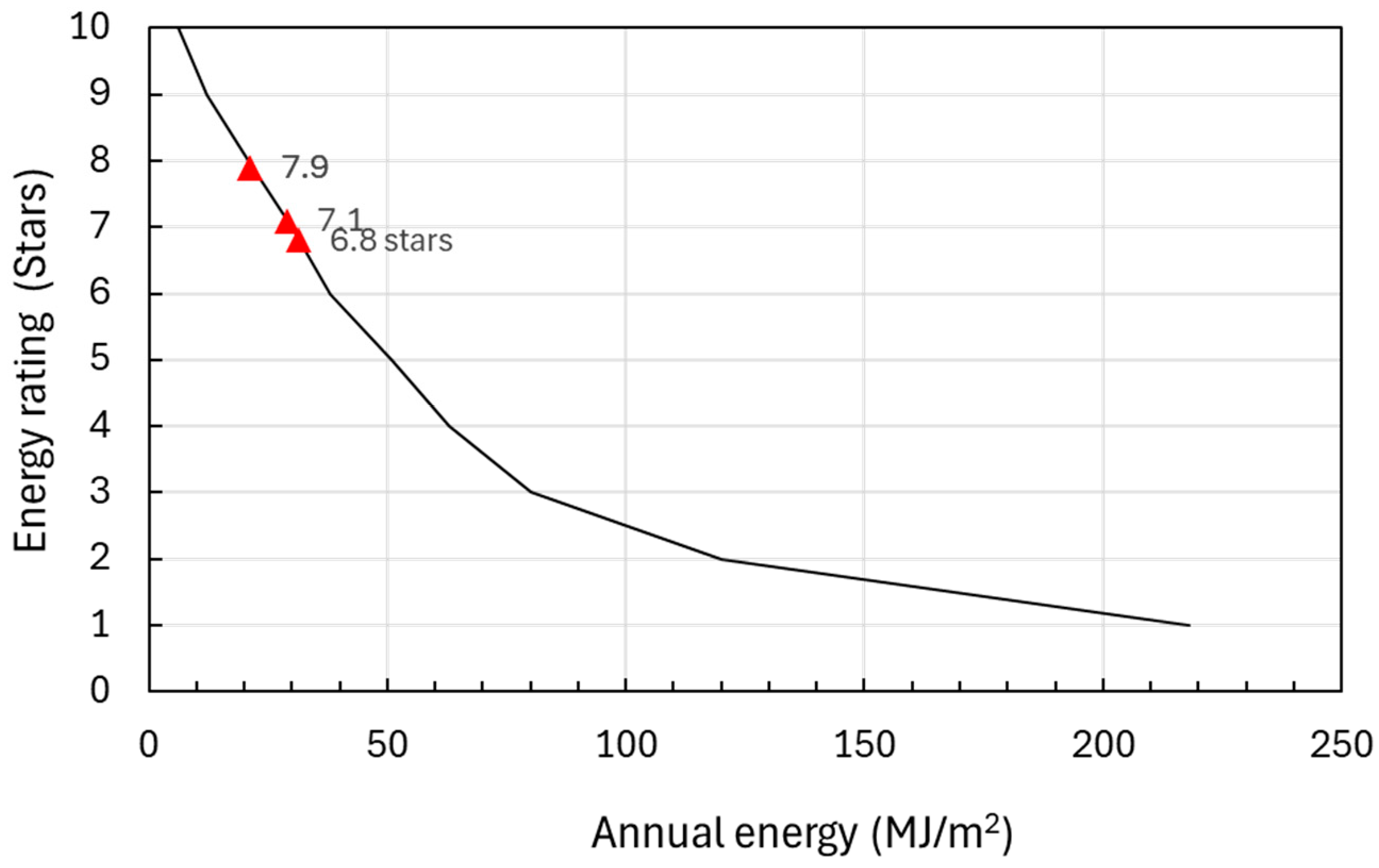
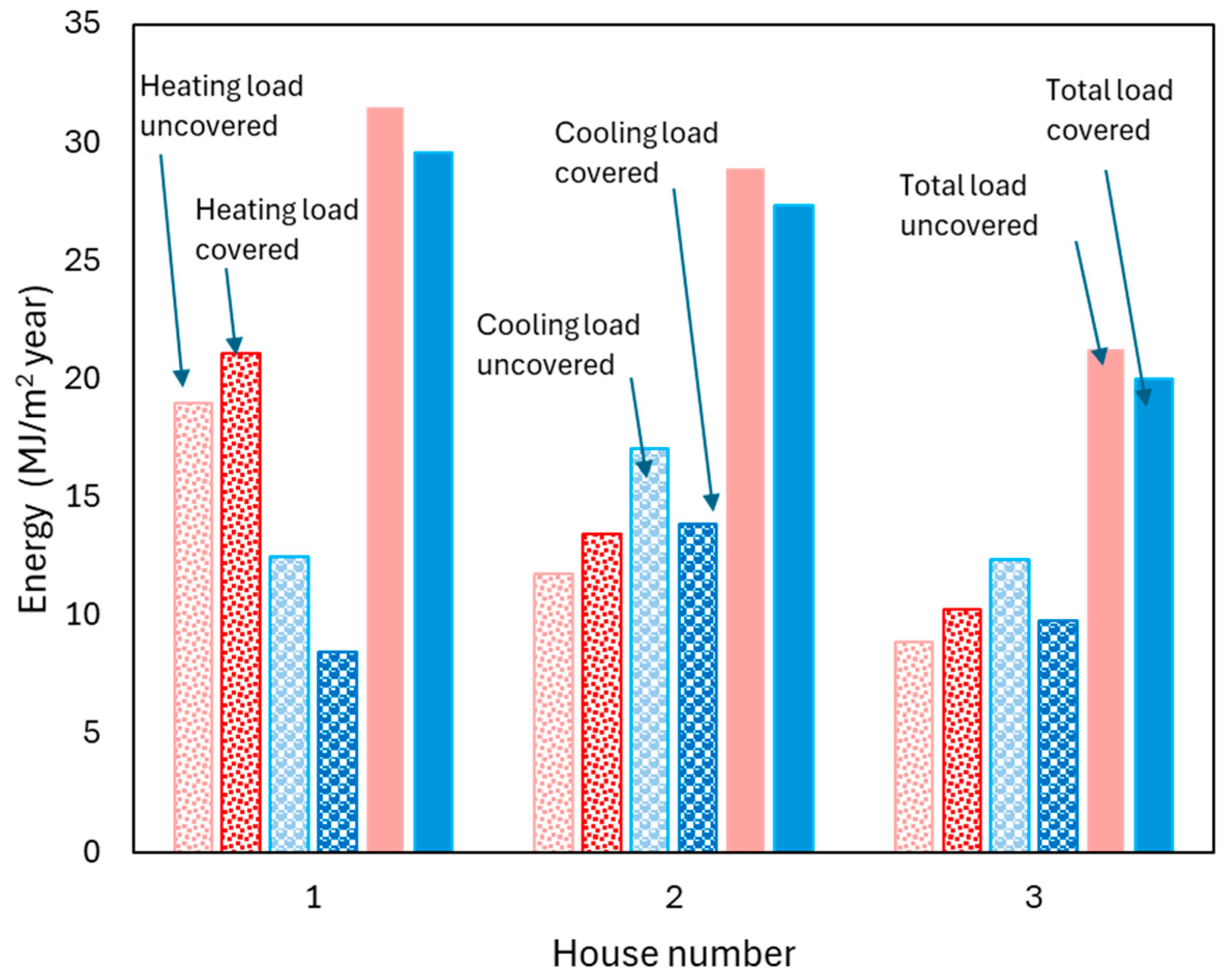
| Reference | Study Location | Major Findings |
|---|---|---|
| Yang, H. et al. [1] | Hong Kong | The study found that installing rooftop PV panels can reduce the cooling load by up to 35% for the specific roof design. |
| Kotak, Y.et al. [2] | India | Computer simulation to investigate the impact of rooftop PV panels on the cooling load of a flat-roofed house. Their findings indicated a notable reduction in cooling load. |
| Dominguez et al. [3] | California, USA | Daytime ceiling temperatures beneath PV arrays were up to 2.5 K cooler than parts of the ceiling below the exposed roof, with a significant reduction in roof heat flux. |
| Kapsalis and Karamanis [4] | Greece (western) | PV panel shading reduced the cooling load by 17.8% but increased the heating load by 6.7%. |
| Buonomano et al. [5] | Naples, Italy | Solar collection devices like PV and PVT had a passive effect on the building’s thermal performance, leading to higher cooling demands and lower heating demands. |
| Wang et al. [6] | Shaanxi, China | Heat gain through flat and tilted overhead PV roofs was reduced by 67.1% and 59%, respectively. Daily cooling load of the flat overhead PV roof decreased by 77.4%, while the tilted overhead PV roof was reduced by 69.4%. |
| Odeh S. [7] | Sydney, Melbourne, Townsville, Australia | Overall change in cooling and heating loads due to PV panel addition to the roof ranged from −5% to +8%, depending on the building orientation and site climate. |
| Shukla et al. [8] | New Mexico, USA | Rooftop tiles under the panels were up to 13 °C cooler, and heat flow to the conditioned internal space was reduced by 49%. |
| Barone et al. [9] | Naples, Milan, Almeria, Italy | Solar collection devices decreased heating loads while increasing cooling loads. |
| Brown et al. [10] | Arizona, USA | PV panels could cause cooling load increases equivalent to 11% of the total electricity generated by the panels on white roofed houses. |
| Pandiaraj et al. [11] | Perundurai, Tamil, Nadu, India | Roof-mounted PV panels significantly reduced cooling loads, reducing internal ceiling temperatures by 2.5 °C. |
| Bhuvad and Udayraj [12] | Raipur +10 other cities, India | PV panels reduced roof and ceiling temperatures between 6 and 11 °C and annual cooling load reductions between 70% and 94%. |
| Ma et al. [13] | Wuhan, China | Shading by tilted PV panels on flat black roofs reduced heat flux by 41.7% and daily indoor heat gain by 74.8%. |
| Vakilinezhad and Ziaee [14] | Ardabil, Rasht, Yazd, and Bandar-Abbas, Iran | PV shading most effective on high solar absorption and low thermal resistance roofs. In warm climates, shading reduced cooling loads, while in cold and moderate climates, it increased heating loads. |
| Zhan et al. [15] | Guangzhou, China | They found that PV panels enhanced thermal performance compared to conventional roofs, reducing daily total heat gain by 29.0–39.2%. |
| Roof Component | Thermal Resistance (m2·°C/W) | Summer | Winter | |
|---|---|---|---|---|
| 1 | Roof Tile | R1 | 0.02 | 0.02 |
| 2 | 40mm Air Gap | R2 | 0.16 | 0.18 |
| 3 | Sarking Material | R3 | 0 | 0 |
| 4 | Attic air space | R4 | 1.36 | 0.34 |
| 5 | Insulation | R5 | 4 | 4 |
| 6 | Plasterboard | R6 | 0.06 | 0.06 |
| 7 | Internal Air Space | R7 | 0.16 | 0.11 |
| Total | Rt | 5.616 | 4.584 |
| House Number | Floor Area Acond (m2) | Roof Area Aroof (m2) | Heating Load Qh (MJ/m2.ann) | Cooling Load Qc (MJ/m2.ann) | Total Load Qtotal (MJ/m2.ann) | Star |
|---|---|---|---|---|---|---|
| 1 | 123 | 108.2 | 19 | 12.5 | 31.5 | 6.8 |
| 2 | 151 | 106 | 11.8 | 17.1 | 28.9 | 7.1 |
| 3 | 200 | 114 | 8.9 | 12.4 | 21.3 | 7.9 |
Disclaimer/Publisher’s Note: The statements, opinions and data contained in all publications are solely those of the individual author(s) and contributor(s) and not of MDPI and/or the editor(s). MDPI and/or the editor(s) disclaim responsibility for any injury to people or property resulting from any ideas, methods, instructions or products referred to in the content. |
© 2025 by the authors. Licensee MDPI, Basel, Switzerland. This article is an open access article distributed under the terms and conditions of the Creative Commons Attribution (CC BY) license (https://creativecommons.org/licenses/by/4.0/).
Share and Cite
Odeh, S.; Pearling, L. Experimental Work to Investigate the Effect of Rooftop PV Panel Shading on Building Thermal Performance. Energies 2025, 18, 3429. https://doi.org/10.3390/en18133429
Odeh S, Pearling L. Experimental Work to Investigate the Effect of Rooftop PV Panel Shading on Building Thermal Performance. Energies. 2025; 18(13):3429. https://doi.org/10.3390/en18133429
Chicago/Turabian StyleOdeh, Saad, and Luke Pearling. 2025. "Experimental Work to Investigate the Effect of Rooftop PV Panel Shading on Building Thermal Performance" Energies 18, no. 13: 3429. https://doi.org/10.3390/en18133429
APA StyleOdeh, S., & Pearling, L. (2025). Experimental Work to Investigate the Effect of Rooftop PV Panel Shading on Building Thermal Performance. Energies, 18(13), 3429. https://doi.org/10.3390/en18133429





